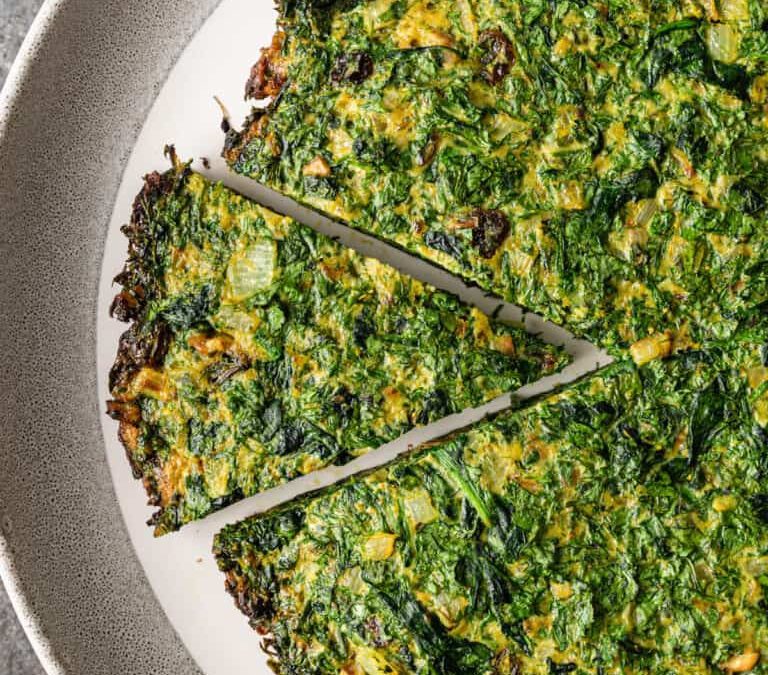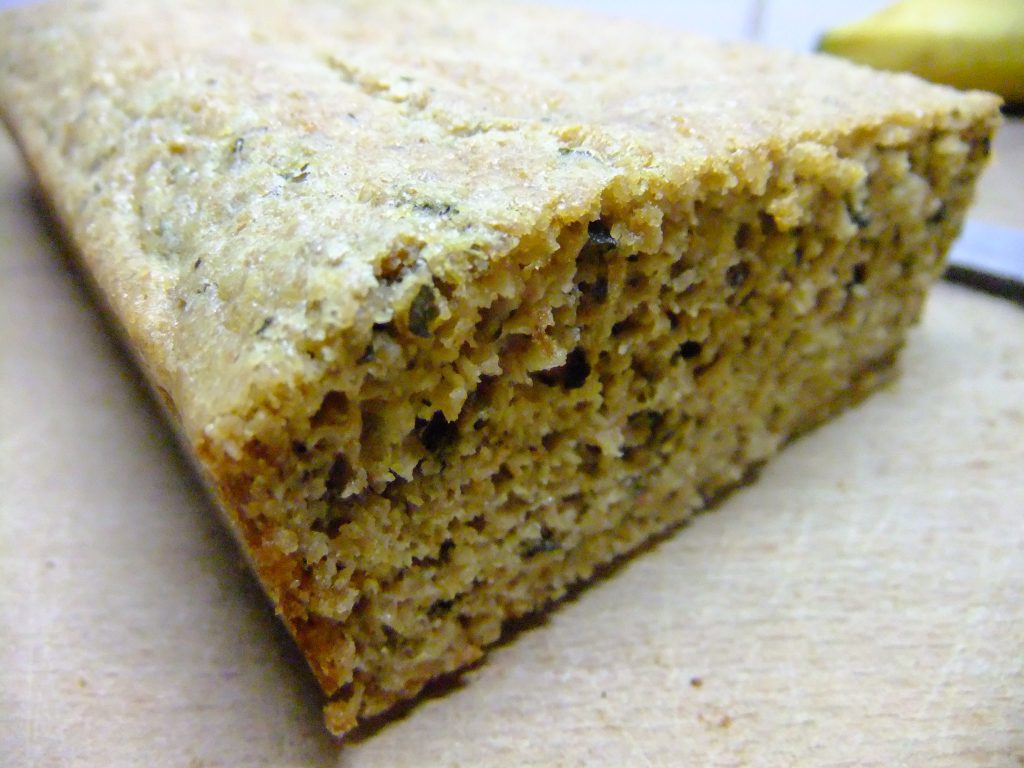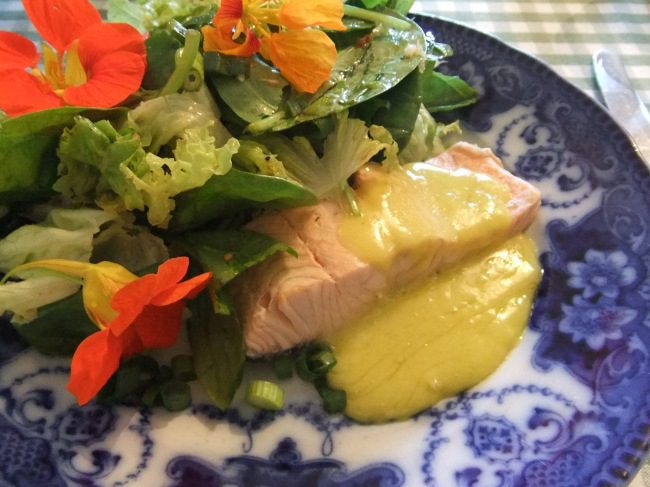
Aug 22, 2018 | Anna's Best Recipes, Main courses, Sides, starters, soups & snacks
I made this for a birthday gathering last week and people LOVED it. It is a baked version of the more oily deep green frittata popular among Persians. There they serve little squares of it with drinks. This quantity makes enough to serve 4 people as part of a mezze meal. Give yourself plenty of time to make it though, it takes a while to process or chop all the herbs. The recipe is from Sabrina Ghayour’s Persiana.
200g flat leaf parsley
200g fresh coriander
40g fresh dill
40g fresh chives
2 bunches spring onions, thinly sliced
3 tbs extra virgin olive oil
2 tsp turmeric powder
8 medium organic eggs
2 tbsp gluten-free flour of your choice (I mix millet, gluten-free oat flour and sorghum or brown rice flour. Or use gluten-free oats blitzed to a flour in your food processor)
2 rounded tbs thick kefir or Greek yoghurt (to thicken your kefir, line a sieve with muslin or a single layer of kitchen paper, strain the kefir, letting the thin whey drain off). If you are very dairy-sensitive you can use natural soya yoghurt instead of Greek yoghurt/kefir (though many dairy-sensitive people can cope with fully fermented home-made kefir because the casein and lactose has been digested by friendly bugs)
3 tsp gluten-free baking powder
½ level tsp Himalayan salt or Atlantic sea salt
freshly ground black pepper
3-4 heaped tbs dried barberries, optional (I buy mine in the Asia Market, Dublin 2)
100g walnut pieces, chopped
Pyrex/ovenproof dish (22x30cm is ideal)
Non-stick baking paper (silicon paper)
1. Preheat the oven to 180C/fan 160C. On a medium heat warm a large cooking pot.
2. Finely chop all the herbs (if using a food processor, do this in 2 batches). Pour the olive oil into the warm pan and sweat the spring onions and herbs for a few minutes, then add the turmeric and stir to mix. Cook for a further 5 mins, then place the herbs on a flat plate and allow to cool.
3. Grease your ovenproof/pyrex dish and line with non-stick baking paper. This makes it easier to remove after everything is cooked.
4. Beat the eggs with the kefir/yoghurt, baking powder, salt, gluten-free flour and about half a level teaspoon of freshly ground black pepper (or to taste).
5. Once the herb mix has cooled so its no longer piping hot, slowly add a couple of spoonfuls at a time to the egg mixture and stir well until all the herb mix is combined. Add in the barberries and walnut and mix well once again.
6. Pour in the egg and herb mixture and bake for 35-40 mins. To check if the frittata is cooked, insert a knife into the centre. If it comes out clear of raw egg, the dish is done. If not, return to the oven for a few minutes. Once cooked, allow to cool, then cut into squares to serve. Enjoy…
Why this is good for you:
All herbs and many spices (especially turmeric) have antioxidant properties, helping reduce inflammation and keep you looking and feeling younger longer. Most herbs and spices have a selective action on your gut bacteria – fostering the helpful bacteria and helping reduce numbers of pathogens (disease-causing ones). Coriander also helps chelate (bind) the toxic metal mercury. If you have mercury dental fillings you are ingesting a significant dose every single time you eat. when coriander is in your gut at the same time it latches on to the mercury and escorts it safely out via your bowel. Onion family veggies also feed good bacteria which are needed for ALL aspects of your health. Green plant foods are rich in magnesium needed for detoxification of the many toxins our body needs to process every day. Magnesium is essential for keeping us calm and happy.

Feb 25, 2015 | Anna's Best Recipes, Breads, crackers, pancakes & wraps
This bread is soft and moist and really filling. It’s such a huge treat when you are off grains! Because its high in protein and fibre (unlike normal breads) you don’t need to eat it with extra protein in order to avoid blood sugar dips and energy crashes. Enjoy it with my special buttery spread for bread, with virgin coconut oil or organic butter (or clarified butter for dairy intolerant people). If you want to increase your energy levels, use the coconut oil as a spread instead of butter (unlike butter, the MCT fraction of coconut oil – about 50% – goes straight into energy production)
Dry ingredients:
100g milled flax seeds. Flax is another name for linseed.
20g ground almonds
½ level tsp Atlantic sea salt or Himalayan salt (NOT ordinary table salt which contains harmful additives)
1 level tsp bicarbonate of soda (also called bread soda)
Plus, if you have it, one of the following
2 tsp dried oregano and 1 level tsp of paprika
1 level tsp Ceylon cinnamon and/or ½ level tsp cardamom
1/2 tsp each ground cumin and coriander
Finely grated rind of organic lemon
Wet ingredients:
2 eggs
1/3 cup (approx. 80ml) water, home made dairy kefir or non-dairy kefir*
1/3 cup extra virgin olive oil
1. Turn on the oven to 150C (or 140C for fan)
2. Mix together all the dry ingredients. In a separate larger bowl whisk or beat together the wet ingredients.
3. Add the dry ingredients to the wet and mix together well.
4. Line a 1lb/450g loaf tin (around 15 x 94 x 74cm) with greased parchment or greaseproof paper, pour in the mix and bake for 50-60 mins.
[If you only have a 2lb loaf tin (around 23 x 13 x 7cm) you can still use it but reduce the baking time to around 40 minutes. The resulting loaf will be half the normal height].
5. The loaf is done when a needle or knife inserted into the thickest part of the bread comes out clean. Remove from oven, remove paper and cool on a wire rack. Refrigerate if you intend keeping it for more than 1-2 days.
Variation
For a deliciously moist courgette flax loaf reduce the amount of kefir/water to 50ml and add 1 medium courgette, finely grated, to the dry ingredients.
*In my tags for this recipe I say this bread is dairy-free, so how come kefir is allowed, when its usually made from milk? This is because, if you make your own kefir properly at home, the problematic milk protein (casein) and lactose (milk sugar) have been broken down by the fermentation process. Kefir “grains” hydrolyse (break down) casein, and digest lactose, turning it into lactic acid. Good news all round, if you are recovering form dairy intolerance. Kefir also contains over 20 different types of beneficial bacteria to help heal digestive issues. Unsweetened non-dairy kefir can be a good option for shop-bought.
Why this is better for you
You may wonder why I mention kefir in a “dairy-free recipe”. Kefir is tolerated by people with dairy intolerance because provided it is properly made (at home) it contains no lactose and no casein. Lactose is the milk sugar that’s problematic in lactose intolerance. Most yoghurts still contain lactose because they are not properly (fully) fermented. Yoghurt you make at home will not contain lactose. Casein is the milk protein that dairy intolerant people react to. Kefir grains “hydrolyse” (digest) casein, leaving you able to eat kefir but not yoghurt, cheese, milk which all still contain casein. This loaf avoids grains completely so its really low in carbohydrates. If you are gluten intolerant or want to follow low GI, ketogenic, stoneage or paleo eating plana, it fits right in. Research shows that if you want to maintain good skin, digestion and keep mentally sharp then low grain low carbohydrate way of eating is really important for you. Flaxseeds are a really rich source of soluble fibre, which feeds good bacteria in your gut which helps your skin, your digestion, and even your brain function!! I would recommend having this bread now and again, rather then every day. This is because heating reduces the levels of beneficial oils in the ground flaxseeds. All nuts and seeds have more benefits when you eat them raw or soaked, rather then cooked. It’s still a million times better than sliced pan though!

Feb 16, 2015 | Anna's Best Recipes, Breads, crackers, pancakes & wraps, Desserts & drinks

Gluten-free pancakes with apple and vanilla yoghurt
These are my “traditional” but gluten-free pancakes and I love them for an occasional treat. They come out pretty similar to traditional wheaty pancakes and we think they are just as nice. I plan to eat these for dessert on Pancake Tuesday with freshly stewed cooking apple (sweetened with pure stevia or xylitol) and a large dollop of Greek yoghurt, natural yoghurt or Coyo coconut yoghurt. Coyo sometimes needs to be thinned thinned with a little non dairy milk when its extremely thick. Of course there’s always the more traditional option to eat them with lashings of lemon juice and a sprinkle of xylitol. Delicious!
For best results make the batter between 2 hours and 2 days before and store in the fridge until ready to use.
110g plus 1 tbs brown rice flour, organic if possible
35g soya flour
½ level tsp Atlantic sea salt or Himalayan (pink) salt
2 eggs
1 tbs virgin macadamia oil or light olive oil
250ml dairy or non-dairy milk of your choice (additive-free unsweetened almond or coconut milk are particularly good)
Virgin coconut oil for cooking
1. Combine all the ingredients and whisk thoroughly with an egg beater or electric mixer or in a blender. the batter should flow like double cream. If it is too thick or thin, adjust with either rice flour or water. Store in the fridge until ready to use.
2. Heat a frying pan over a medium-high heat. too low a temperature will produce tough crepes, too high will burn them before they are cooked. Add a knob of coconut oil (about the size of the top part of your thumb) to the pan before cooking each crepe.
3. Pour the batter (about an eight per crepe) into the hot frying pan, tilting the pan to distribute batter evenly and thinly. Pour out any excess.
4. Cook until the top appears dry, about 1 minute. Lift with edge of a heatproof spatula and if the bottom is golden, easy the whole crepe up with the spatula and turn. cook about 1 minute more. Crepes can be stacked and kept warm in a low oven.
Why these are better for you:
The soya flour and eggs in these is high in protein, so you are less likely to have a blood sugar rush and crash after these, even if you eat them on their own. Erratic blood sugar plays a massive part in skin problems, accelerated ageing process, stress and digestive issues.
Unfermented soya products like soya flour (and soya milk) are not an especially healthy option to eat every day because they bind (stick to) essential minerals, making it hard for your body to digest them. That’s why I recommend these pancakes for occasional treats rather than every day. In contrast to soya flour and soya milk, fermented soya products are beneficial and can help reduce the hormonal imbalances that lead to breast and prostate issues. Examples of fermented soya products are miso, tempeh and soya yoghurt. So best keep soya flour and soya milk for occasional treats. Coconut oil is fantastic for your brain, your skin and even your digestive system. Unlike many oils, it is not made harmful by normal domestic cooking heat.

Jul 25, 2013 | Anna's Best Recipes, Dressings, rubs, spreads, sauces & more
This is a traditional southern French garlic mayonnaise at its best. Always makes me think of holidays. The other day I ate a generous dollop on some poached salmon with a large salad with nasturtium flowers from the garden. Aioli is fantastic with poached or baked fish, cold meat, or hard-boiled eggs in a salad. If you like a more neutral-tasting mayo, you can use equal parts olive and a second cold-pressed (extra virgin) neutral-tasting oil such as sunflower or rapeseed. Do not use refined (non-cold-pressed) seed/nut oils as they are damaging to health. Aioli will keep for about 5 days in a glass jar in the coldest part of the fridge. The garlic helps preserve the raw eggs. It’s quicker to make aioli using an electric whisk than with the pestle and mortar. But don’t try to make it in a blender because it never thickens up for me using one!
For 4 servings:
3 cloves garlic
1 organic egg yolk, at room temperature (this helps the mixture not to “split” or separate)
150ml (approx) extra virgin olive oil (or half olive oil half raw cold-pressed sunflower or rape oil), also at room temperature
A pinch of Atlantic sea salt or Himalayan salt (optional)
You will need:
A pestle and mortar and/or an electric whisk
Pestle and mortar method:
- Peel the garlic, slice into slivers, and pound to a paste with a pinch of salt, add the egg yolk, and mix in. Pounding the garlic gives a different (and in my opinion, subtler) flavour from just crushing it with a garlic crusher.
- You can now either continue making the aioli with the pestle and mortar or (for less work) transfer the garlic/yolk mix to a bowl and get out your electric hand whisk before starting to add the oil as follows:
- Beat in the oil, at first drop by drop, and then, as the mix begins to thicken and resemble mayonnaise, add more liberally but never in a heavy stream. It is ready when it looks thick and creamy. See below for instructions on what to do if it goes wrong.
Electric whisk method:
1. Crush the garlic (with a garlic crusher if you have one, otherwise crush with the back of a knife, using a pinch of salt to really grind up the garlic). Add to a bowl.
2. Add the egg yolk and whisk with an electric whisk for a minute.
3. Beat in the oil, at first drop by drop, and then, as the mix begins to thicken and resemble mayonnaise, add more liberally but never in a heavy stream. If you add it too quickly the mixture will split and never thicken. It is ready when it looks thick and creamy.
To rescue “split” aioli:
Get a fresh (room temperature) egg yolk and start beating it. While beating, VERY gradually and a drop at a time, start adding in the “split” mixture as if it were just oil. Very gradually incorporate the split mixture into the egg yolk, beating continuously, until you have a thick, creamy aioli.
Variations:
Add the zest of an organic lemon and 1 tbsp fresh lemon juice to room-temperature aioli (if it’s not at room temperature, adding the lemon juice will make it split). Mix well. You could also add 2 tbsp chopped parsley too.
Why this is good for you:
Cold-pressed raw oils are fantastic for your health! The raw oils from sunflower, rape, and sesame are rich in polyunsaturated omega 6 oils, while extra virgin olive oil is high in monounsaturated oils and vitamin E, a powerful antioxidant. Omega 6 is fine in small amounts whereas you can enjoy unlimited extra virgin olive oil. These oils can help weight management, enhance skin health and also moisturize your skin from within. You will need to keep raw cold-pressed nut/seed oils in the fridge as they are fragile and easily go off, losing their health benefits. Refined or fried oils (all supermarket oils except extra virgin olive and cold-pressed rapeseed oil and extra virgin coconut oil) disrupt hormone balance and contribute to weight gain and visible aging. Studies have shown people lose weight when they ADD extra virgin olive oil (and raw nuts) to their diets! High-quality oils make you feel fuller longer. Never cook with polyunsaturated oils, only use them raw and cold-pressed.





